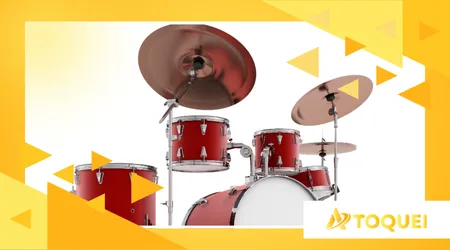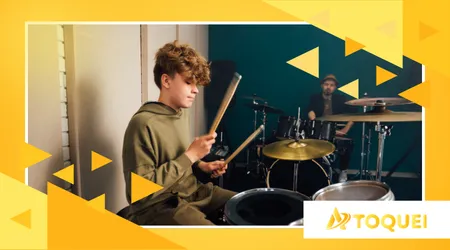How to choose the first acoustic drum kit for beginners

The process of choosing the first acoustic drum kit for beginners It may seem like a complex journey, full of technical terms and uncertainties.
Advertisements
At first, the task of selecting the ideal kit is like navigating an ocean of options.
Don't worry, the choice becomes less daunting with the right knowledge. This guide is designed to illuminate the path, making your search more informed.
After all, your musical journey starts with the right decision.
In this article, we'll demystify the world of acoustic drums. Get ready to learn about the essential elements that make up a kit.
Advertisements
The Heart of the Drums: Getting to Know the Essential Parts
First and foremost, understanding the anatomy of a drum kit is crucial. A standard kit consists of a set of drums and cymbals.
Essential drums include the bass drum, snare drum, and tom-toms. The bass drum, the largest drum, provides the bass and pulse. The snare drum, in turn, is the heart of rhythm and cadence.
The toms, mounted on the bass drum, and the floor tom, on the floor, offer melodic variations. The interconnection of these elements creates a solid foundation.
The basic kit also includes hardware and pedals. The bass drum pedal controls the bass beat. The hi-hat is a double cymbal.
These cymbals are operated by a pedal. Finally, the ride cymbal and crash cymbal complete the set.
Size, Wood, and Hardware: The Golden Trio

Drum size directly affects the sound. Beginner kits typically have smaller drums.
These dimensions make it easier for the musician to transport and adapt. A practical example: a 20-inch kit is more versatile.
++Family Music: How Parents and Children Can Play Together
The wood of the drum shell is another factor. Popularly, poplar wood stands out for its versatility.
It offers a balanced sound and attractive value for money. Birch and maple are more noble woods.
They are reserved for professional drums. The choice of wood impacts resonance.
The hardware, in turn, ensures the kit's stability. Sturdy, durable supports are essential.
They hold drums and cymbals. Quality hardware prevents future problems.
The Importance of Price in Your Decision
Price is a decisive factor. In the battery market, prices vary.
Starter kits cost between R$ 2,500 and R$ 6,000. This price range is ideal for beginners.
++Difference between classical, folk and jumbo guitar: which one to choose?
These models offer a combination of quality and affordability. They're the ideal starting point.
Market research is essential before purchasing. Consider the different brands and models available.
New or Used? A Thoughtful Analysis
Buying a new kit comes with a warranty. You know the product's origin.
On the other hand, a used battery can be an option. It's more economical.
It's important to check the integrity of the kit. Look for signs of wear.
++Are Electronic Drums Good for Beginners? Advantages and Limitations
Assess the heads, hardware, and overall condition. Ask an experienced drummer for help.
He can help you choosing the first acoustic drum kit for beginners. Your expertise will prevent a bad purchase.
To illustrate the process, let's look at practical examples. Kits like the one from Odery Fluence are excellent.
Another popular option is Pearl Roadshow. These kits are designed for beginners.
They offer excellent value for money. Both are highly recommended.
Final Considerations and Golden Tips
Don't underestimate the importance of testing your instrument. Test out the kit at an instrument store.
Feel the weight of the pedals, the response of the drums. Feel at ease with the instrument.
Remember the shoe analogy. The battery, like the shoe, must fit perfectly.
Don't just focus on aesthetics. Sound and ergonomics matter more.
A 2024 survey conducted by the Brazilian Music Association (ABRAMUS) revealed that 65% of drum beginners give up within the first six months.
This alarming statistic shows that choosing the right drum kit is more important than you might think. After all, frustration with a low-quality instrument is a major factor in giving up.
Frustration is a common feeling for many beginners. Avoid this trap.
Choosing the first acoustic drum kit for beginners conscious and informed thinking is key. Think long-term about your journey.
Could choosing the wrong instrument be the culprit behind your passion for music? Of course. A good choice fuels passion.
A common mistake is purchasing an incomplete kit. The kit must come with the drums and hardware.
The same applies to cymbals, which require stands. A complete kit includes everything.
The drums are an extension of the musician. Therefore, your choice affects your evolution.
The comfort and quality of the instrument motivate practice. A good instrument facilitates learning.
It's a decision worth considering. Your future musical career depends on it.
Decision Time: Summary of Where to Focus
To help you, see the table below with the main points to consider when choosing the first acoustic drum kit for beginners.
| Feature | Importance | What to evaluate |
| Size | Essential | Smaller kits (20 inches or less) are ideal for limited spaces and easy transport. |
| Wood | Very Important | Poplar is the best option for beginners due to its value for money and balanced sound. |
| Hardware | Critical | Check the stability and robustness of the supports. Quality hardware ensures durability. |
| Price | Decisive | Starter kits (R$ 2,500 – R$ 6,000) offer good value for money. |
| Brands | Important | Brands like Odery, Pearl, and Tama are known for their quality and entry-level kits. |
The decision to choosing the first acoustic drum kit for beginners is a milestone. It represents the beginning of a new phase.
Choose the drum kit that inspires you. The one that makes you want to sit down and play.
In the end, the right choice is the one that keeps you motivated. The journey is as important as the destination.
Your drums are your companions. And the beginning of this friendship should be well planned.
Now you are ready to choosing the first acoustic drum kit for beginners. Good luck and happy beating!
Frequently Asked Questions
Q: Do I need to buy a complete kit with cymbals?
A: Yes, most beginner kits come with a basic set of cymbals (hi-hat and crash). If they don't, we highly recommend purchasing them.
Q: Is it better to start with electronic drums?
A: Electronic drums are a good alternative for those with space or noise constraints, but the feel and sound of acoustic drums are unique. The choice depends on your priorities.
Q: What is the best wood for a first drum set?
A: Poplar wood is the best choice because it is versatile, affordable and offers a quality sound that pleases most beginner drummers.
Q: Can I learn on my own or do I need a teacher?
A: You can start on your own, but a teacher can accelerate your learning, correct incorrect postures and teach proper techniques, avoiding posture and technique defects.
